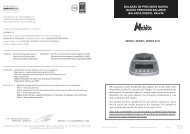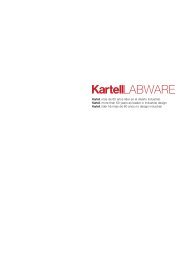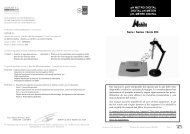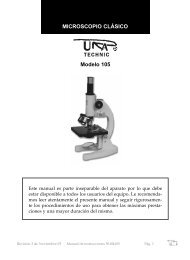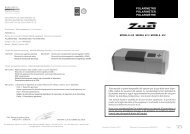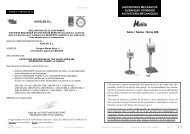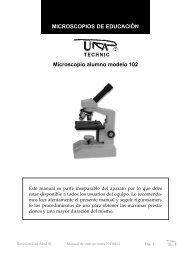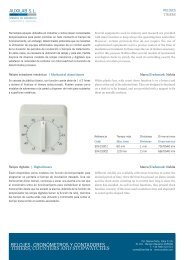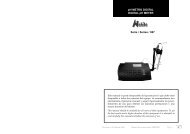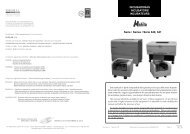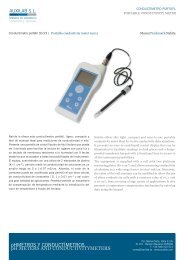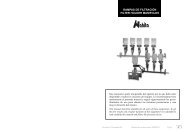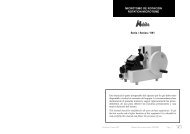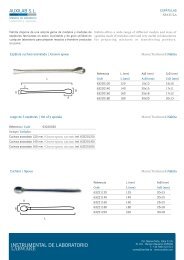CUBETA DE ELECTROFORESIS VERTICAL VERTICAL ... - Auxilab
CUBETA DE ELECTROFORESIS VERTICAL VERTICAL ... - Auxilab
CUBETA DE ELECTROFORESIS VERTICAL VERTICAL ... - Auxilab
You also want an ePaper? Increase the reach of your titles
YUMPU automatically turns print PDFs into web optimized ePapers that Google loves.
ENGLISHGel thicknessAcrylamide volume1 gel 2 gelsDiscontinuous Continuous Discontinuous Continuous1.0 mm 3.4 mL 6.7 mL 6.7 mL 13.5 mL1.5 mm 5 mL 10 mL 10 mL 20 mL- Carefully pipet the resolving acrylamide gel filling the space between bothglass plates until 1 or 2 mm above the desired level. Overlay the solution with a few dropsof water-saturated n-butanol to eliminate bubbles and separate the gel from the air oxygen(inhibitor of polymerization).- Wait until the gel polymerizes (15-30 min); polymerization is faster at 4 ºC.Note: keep the assembly vertical while the acrylamide polymerizes.- After the resolving gel has polymerized, pour off any unpolymerized solutionand n-butanol. Rinse the top of the gel with deionized water and drain thoroughly.- Add the stacking gel solution to within 2 mm of the top of the notched plate.Eliminate any bubble formed.- Insert completely the comb. Be careful not to trap bubbles under and betweenthe comb teeth.- Allow the acrylamide solution to polymerize completely.2. Continuous buffer system gels- Prepare the volume of acrylamide solution depending on gel thickness (Chart 1).- Carefully pipet the acrylamide solution filling the space between both glass platesto within 2 mm of the top of the notched plate. Eliminate any bubble formed.- Insert completely the comb. Be careful not to trap bubbles under and betweenthe comb teeth.- Allow the acrylamide solution to polymerize completely.• Assembly for gel electrophoresis and sample loadingGel electrophoresis is performed on the same support in which it has been cast, minimizinggel manipulation and speeding up and making work easier.Proceed as follows:- Turn the handles of the gel casting device to their original position.- Take off the support with the polymerized gels from the gel casting device andput it into the electrophoresis tank. Note: the special design of the tank and the gel supportallows to fit them at the correct position.- Carefully remove the comb by pulling it vertically and rinse with deionizedwater.- Fill the central part of the gel support with approximately 150 mL of electrophoresisbuffer. Make sure that the wells are completely covered with buffer.- Carefully rinse the wells with deionized water or electrophoresis buffer to eliminatebubbles or acrylamide fragments. Use a syringe or pipette.- Load the samples into the wells with a micropipette. The sample volume thatcan be loaded in each well depending on gel thickness is shown in chart 2. Note: samplesPage 22 Instruction manual 53001001 Version 1 May-07CASTELLANONota: si se va a realizar la electroforesis de un único gel, en el otro compartimento delsoporte para geles inserte la aplaca de vidrio gruesa y a continuación la cuña. Si se vana utilizar dos geles, proceda de la manera anteriormente indicada para la preparación delsegundo gel.Coja el dispositivo para la preparación delgel y coloque en su base la almohadilla desilicona. Nota: La almohadilla debe estarperfectamente limpia y seca. Después de lapreparación del gel, retire la junta de silicona,lávela con agua y déjela secar al aire. Noutilice ningún otro método para la limpiezade la junta.Coloque el soporte en el dispositivo parapreparación de geles. La base del soportedebe quedar perfectamente sellada con lajunta de silicona para evitar fugas a la horade añadir la solución de acrilamidaPresione hacia adentro las palancas blancassituadas a cada lado del dispositivo depreparación de geles; gírelas simultáneamentehasta que las flechas señalen la posiciónadecuada según el grosor del gel (cadapalanca presenta marcas con indicación 1.5 ó1.0 que hacen referencia al grosor del gel; siestá preparando geles de 1.5 mm grosordeberá girar las palancas hasta que las flechasseñalen las marcas con la anotación 1.5).• Preparación del gelNota: no toque las palancas del dispositivo durante todo el proceso de preparación delgel, ya que se podría aflojar el montaje produciendo fugas de las soluciones de acrilamida.1. Sistema tampón discontinuoEste sistema es especialmente adecuado para analizar muestras diluidas sin perderresolución. La preparación del gel se debe realizar con dos tampones distintos. De estamanera, el primer tampón (primera parte del gel, "stacking gel") asegura la migración detodas las proteínas en el frente de migración, produciéndose la acumulación de todas lasproteínas cargadas en el pocillo. Cuando el frente de migración llega al segundo tampón(gel resolutivo o de separación) comienza realmente la separación de las proteínas.Revisión 1, Mayo-07 Manual de instrucciones 53001001 Pág. 7



